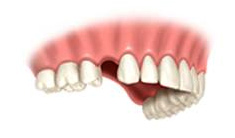Single Tooth Replacement

SINGLE TOOTH MISSING
Benefits of an all-ceramic crown on implant: When both the tooth and root are damaged, the best permanent replacement is a dental implant in conjunction with a ceramic crown. This solution both looks and functions just like a natural tooth.In this case, a so-called one-piece implant is used. This means that all components are installed as a single unit, resulting in immediately full functioning teeth, shorter treatment time and minimized pain.
1. Immediately functioning teeth
2. Excellent esthetic result
3. Life long, stable solution
Treatment: This procedure normally includes four visits to the dentist. You should expect to be able to work the day after having the implant installed.
COURSE OF TREATMENT - INSTALLING THE NEW TOOTH – STEP-BY-STEP
The course of treatment described here is one of several options available. Consult your dentist to find out what the best solution is for you, given your specific condition.
1: Before the procedure - The dentist makes a first examination and takes one or more x-rays of the area to prepare for the procedure.

2: Installing the implant - The implant is installed. At this time, a temporary tooth is provided that allows you eat and function like normal almost immediately. The implant will need a few months to integrate with the jawbone before the next step is taken.

3: Attaching the new crown - The final step is the placement of the permanent ceramic tooth. The new tooth is installed for life. No additional treatment is needed.

4: End result - You should expect the new tooth to fit and function just like a natural tooth. Do your usual dental hygiene to keep the tooth and gum around it clean.
ALTERNATIVES TO AN ALL-CERAMIC CROWN ON IMPLANT

Tooth-supported fixed bridge
A traditional bridge involves grinding down adjacent teeth to support the bridge. It is a stable solution with good esthetics and function that is fairly easy to install. However, this alternative has two main disadvantages: continuous bone resorbtion in the edentulous area, and sacrificing healthy teeth on behalf of the bridge.
Removable partial denture
This is not a permanent alternative to a lost tooth. It is unstable and loosely attached, which affects both function and comfort. A removable partial denture is made of plastic – a material that can't create the same esthetic result as a ceramic crown. The benefits are few but do exist: adjacent teeth aren't affected. It is easily and quickly installed and relatively cheap.
